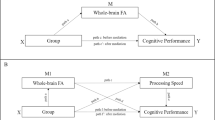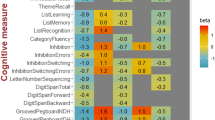Abstract
We examined variability in performance on widely-used neuropsychological Wechsler tests of intelligence and memory in a large sample of persons with chronic schizophrenia, a subset of whom had also undergone prior studies of magnetic resonance imaging (MRI) of the orbital frontal cortex (OFC) gray matter and diffusion tensor imaging (DTI) of the cingulum bundle (CB) and the uncinate fasiculus (UF) white matter. In comparison to controls, persons with schizophrenia showed lower scores across neuropsychological tests, with most pronounced drops in processing speed and immediate memory, in relation to oral reading. For patients, greater declines in intelligence and memory each correlated with reduced CB white matter fractional anisotropy and reduced OFC gray matter, respectively. However, only memory decline correlated with severity of negative symptoms. Taken together, these data raise the intriguing question as to whether communication and motivational deficits expressed in negative symptoms may contribute to the relationship of auditory memory decline and OFC volume observed in this patient sample.
Similar content being viewed by others
References
Aleman, A., Hijman, R., de Haan, E. H. F., & Kahn, R. S. (1999). Memory impairment in schizophrenia: a meta-analysis. American Journal of Psychiatry, 156(9), 1358–1366.
Andreasen, N. (1983). The Scale for the Assessment of Negative Symptoms (SANS). Iowa City: The University of Iowa.
Andreasen, N. (1984). The Scale for the Assessment of Positive Symptoms (SAPS). Iowa City: The University of Iowa.
Armstrong E, Schleicher A, Omran H, Curtis M, & Zilles K. (1995). The ontogeny of human gyrification. Cerebral Cortex, 5, 56–63.
Bonner-Jackson, A., Grossman, L. S., Harrow, M., & Rosen, C. (2010). Neurocognition in schizophrenia: a 20-year multi-follow-up of the course of processing speed and stored knowledge. Comprehensive Psychiatry, 51(5), 471–479.
Bouix, S., Martin-Fernandez, M., Ungar, L., Nakamura, M., Koo, M. S., McCarley, R. W., et al. (2007). On evaluating brain tissue classifiers without a ground truth. Neuroimage, 36, 1207–1224.
Cannon, T. D., Huttunen, M. O., Lonnqvist, J., Tuulio-Henriksson, A., Pirkola, T., Glahn, D., et al. (2000). The inheritance of neuropsychological dysfunction in twins discordant for schizophrenia. American Journal of Human Genetics, 67(2), 369–382.
Censits, D. M., Ragland, J. D., Gur, R. C., & Gur, R. E. (1997). Neuropsychological evidence supporting a neurodevelopmental model of schizophrenia: a longitudinal study. Schizophrenia Research, 24(3), 289–298.
Chiavaras, M. M., & Petrides, M. (2000). Orbitofrontal sulci of the human and macaque monkey brain. The Journal of Comparative Neurology, 422(1), 35–54.
Cohen, J., & Cohen, P. (1975). Applied multiple regression/correlational analysis for the behavioral sciences. Hillsdale: Lawrence Erlbaum Associates.
Curtin, F., & Schulz, P. (1998). Multiple correlations and Bonferroni’s correction. Biological Psychiatry, 44(8), 775–777.
Dalby, J. T., & Williams, R. (1986). Preserved reading and spelling ability in psychotic disorders. Psychological Medicine, 16, 171–175.
Duvernoy H. M. (1999). The human brain: surface, three-dimensional sectional anatomy with MRI, and blood supply. New York, NY: Springer-Verlag Wien.
Egan, M. F., Goldberg, T. E., Gscheidle, T., Weirich, M., Rawlings, R., Hyde, T. M., et al. (2001). Relative risk for cognitive impairments in siblings of patients with schizophrenia. Biological Psychiatry, 50, 98–107.
Egeland, J., Sundet, K., Rund, B. R., Asbjornsen, A., Hugdahl, K., Landro, N. I., et al. (2003). Sensitivity and specificity of memory dysfunction in schizophrenia: a comparison with major depression. Journal of Clinical and Experimental Neuropsychology, 25(1), 79–93.
First, M. B., Spitzer, R. L., Gibbon, M., & Williams, J. B. W. (2002). Structured clinical interview for DSM-IV-TR Axis I Disorders, Research Version, Patient Edition (SCIDI/P). New York: Biometrics Research, New York State Psychiatric Institute.
Harvey, P. D., Friedman, J. I., Bowie, C., Reichenberg, A., McGurk, S. R., Parrella, M., et al. (2006). Validity and stability of performance-based estimates of premorbid educational functioning in older patients with schizophrenia. Journal of Clinical and Experimental Neuropsychology, 28(2), 178–192.
Heaton, R. K., ladsjo, J. A., Palmer, B. W., Kuck, J., Marcotte, T. D., & Jeste, D. V. (2001). Stability and course of neuropsychological deficits in schizophrenia. Archives of General Psychiatry, 58(1), 24–32.
Heinrichs, R. W., & Zakzanis, K. K. (1998). Neurocognitive deficit in schizophrenia: a quantitative review of the evidence. Neuropsychology, 12(3), 426–445.
Kay, S. R., Opler, L. A., & Fiszbein, A. (1986). Positive and Negative Syndrome Scale (PANNS) Manual. North Tonawanda: Mental Health Systems, Inc.
Keefe, R. S. E., Eesley, C. E., & Poe, M. P. (2005). Defining a cognitive function decrement in schizophrenia. Biological Psychiatry, 57, 688–691.
Knowles, E. E., David, A. S., & Reichenberg, A. (2010). Processing speed deficits in schizophrenia: reexamining the evidence. American Journal of Psychiatry, 167(7), 828–835.
Kraepelin, E. (1919). In G. M. Robertson (Ed.), Dementia praecox and Paraphrenia (trans: Barclay, R.M.). New York: Robert E. Kriege. reprinted 1971.
Kremen, W. S., Seidman, L. J., Faraone, S. V., & Tsuang, M. T. (2008). IQ decline in cross-sectional studies of schizophrenia: Methodology and interpretation. Psychiatry Research, 158, 181–194.
Kremen, W. S., Seidman, L. J., Pepple, J. R., Lyons, M. J., Tsaung, M. T., & Faraone, S. V. (1994). Neuropsychological risk indicators for schizophrenia: a review of family studies. Schizophrenia Bulletin, 20, 103–119.
Kringelbach, M. L. (2005). The human orbitofrontal cortex: linking reward to hedonic experience. Nature reviews. Neuroscience, 6(9), 691–702.
Kubicki, M., Westin, C. F., Nestor, P. G., Wible, C. G., Frumin, M., Maier, S. E., et al. (2003). Cingulate fasiculus integrity disruption in schizophrenia: a magnetic resonance diffusion tensor imaging study. Biological Psychiatry, 54(11), 1171–1180.
Kubicki, M., Westin, C.-F., Maier, S. E., Frumin, M., Nestor, P. G., Salisbury, D. F., et al. (2002). Uncinate fasiculus findings in schizophrenia: a magnetic resonance diffusion tensor imaging study. American Journal of Psychiatry, 159(5), 813–820.
Mesulam M.M. (1985). Principles of behavioral and cognitive neurology. Philadelphia: F.A. Davis.
Mohamed, S., Paulsen, J. S., O’Leary, D., Arndt, S., & Andreasen, N. (1999). Generalized cognitive deficits in schizophrenia: a study of first-episode patients. Archives of General Psychiatry, 56(8), 749–754.
Morecraft, R.J., Geula, C., & Mesulam, M.M. (1992). Cytoarchitecture and neural afferents of orbitofrontal cortex in the brain of the monkey. Journal of Comparative Neurology, 323, 341–7358.
Nakamura, M., Nestor, P. G., Levitt, J. J., Cohen, A., Kawashima, T., Shenton, M. E., et al. (2008). Orbitofrontal volume deficit in schizophrenia and thought disorder. Brain, 131, 180–195.
Nakamura, M., Nestor, P. G., McCarley, R. W., Levitt, J. J., Hsu, L., Kawashima, T., et al. (2007). Altered orbitofrontal sulcogyral pattern in schizophrenia. Brain: A Journal of Neurology, 130(Pt 3), 693–707.
Nestor, P. G., Kubicki, M., Gurrera, R. J., Niznikiewicz, M., Frumin, M., McCarley, R. W., et al. (2004). Neuropsychological correlates of diffusion tensor imaging in schizophrenia. Neuropsychology, 18, 629–637.
Nestor, P. G., Kubicki, M., Niznikiewicz, M., Gurrera, R. J., McCarley, R. W., & Shenton, M. E. (2008). Neuropsychological disturbance in schizophrenia: a diffusion tensor imaging study. Neuropsychology, 22(2), 246–254.
Nestor, P. G., Niznikiewicz, M., & McCarley, R. W. (2010). Distinct contribution of working memory and social comprehension failures in neuropsychological impairment in schizophrenia. Journal of Nervous and Mental Disease, 198(3), 206–212.
Nestor, P. G., Nakamura, M., Niznikiewicz, M., Thompson, E., Levitt, J. J., Choate, V., et al. (2012). In search of the functional neuroanatomy of sociality: MRI subdivisions of frontal cortex and social cognition. Social, Cognitive, and Affective Neuroscience. doi:10.1093.
Ono, K., Yamamuro, T., Nakamura, T., & Kokubo, T. (1990). Mechanical properties of bone after implantation of apatite-wollastonite containing glass ceramic-fibrin mixture. Journal of Biomedical Materials Research, 24(1), 47–63.
Pandya, D.N., Van Hoesen, G.W., & Mesulam, M.M (1981). Efferent connections of the cingulate gyrus in the rhesus monkey. Experimental Brain Research, 42, 319–330
Potter, A. I., & Nestor, P. G. (2010). IQ subtypes in schizophrenia: distinct symptom and neuropsychological profiles. Journal of Nervous and Mental Disease, 198(8), 580–585.
Rakic P. (1988). Specification of cerebral cortical areas. Science, 241, 170–176.
Riley, E. M., McGovern, D., Mockler, D., Doku, V. C., OCeallaigh, S., Fannon, D. G., et al. (2000). Neuropsychological functioning in first-episode psychosis-evidence of specific deficits. Schizophrenia Research, 43(1), 47–55.
Saykin, A. J., Saykin, A. J., Shtasel, D. L., Gur, R. E., Kester, D. B., Mozley, L. H., et al. (1994). Neuropsychological deficits in neuroleptic naı¨ve patients with first-episode schizophrenia. Archives of General Psychiatry, 51, 124–131.
Seidman, L. J., Faraone, S. V., Goldstein, J. M., Kremen, W. S., Horton, N. J., Makris, N., et al. (2002). Left hippocampal volume as a vulnerability indicator for schizophrenia: a magnetic resonance imaging morphometric study of nonpsychotic first-degree relatives. Archives of General Psychiatry, 59(9), 839–849.
Seidman, L. J., Giuliano, A. J., Smith, C. W., Stone, W. S., Glatt, S. J., Meyer, E., et al. (2006). Neuropsychological functioning in adolescents and young adults at genetic risk for schizophrenia and affective psychoses: results from the Harvard and Hillside Adolescent High Risk Studies. Schizophrenia Bulletin, 32(3), 507–524.
van den Heuvel, M. P., Mandl, R. C., Kahn, R. S., & Hulshoff Pol, H. E. (2009). Functionally linked resting-state networks reflect the underlying structural connectivity architecture of the human brain. Human Brain Mapping, 30(10), 3127–3141.
Vogt, B.A., & Pandya, D.N. (1987). Cingulate cortex of the rhesus monkey: II. Cortical afferents. Journal of Comparative Neurology, 262, 271–289
Wechsler, D. (1997a). Manual for the Wechsler adult intelligence scale (3rd ed.). San Antonio: Psychological Corporation.
Wechsler, D. (1997b). Wechsler Memory Scale — Third edition (WMS-III). San Antonio: The Psychological Corporation.
Wilkinson, G. S. (1993). Wide Range Achievement Test Revision 3. Wilmington: Wide Range, Inc.
Woodberry, K. A., Seidman, L. J., Giuliano, A. J., Verdi, M. B., Cook, W. L., & McFarlane, W. R. (2010). Neuropsychological profiles in individuals at clinical high risk for psychosis: relationship to psychosis and intelligence. Schizophrenia Research, 123(2–3), 188–198.
Acknowledgments
This work was supported by the National Institute of Health (K02 MH 01110 and R01 MH 50747 to Martha E. Shenton, R01 MH 40799 and P50 080272 to Robert W. McCarley, RO1 MH 63360 to and Margaret Niznikiewicz, R03 MH068464-01 to Marek Kubicki), National Alliance for Research on Schizophrenia and Depression (Marek Kubicki), the Department of Veterans Affairs Merit Awards (Martha E. Shenton, James J. Levitt and Margaret Niznikiewicz, Paul G. Nestor and Robert W. McCarley), and the Department of Veterans Affairs Schizophrenia Center (Robert W. McCarley). This work is also part of the National Alliance for Medical Image Computing (NAMIC), funded by the National Institutes of Health through the NIH Roadmap for Medical Research, Grant U54 EB005149 (Martha E. Shenton and Marek Kubicki).
Author information
Authors and Affiliations
Corresponding author
Rights and permissions
About this article
Cite this article
Nestor, P.G., Kubicki, M., Nakamura, M. et al. Neuropsychological variability, symptoms, and brain imaging in chronic schizophrenia. Brain Imaging and Behavior 7, 68–76 (2013). https://doi.org/10.1007/s11682-012-9193-0
Published:
Issue Date:
DOI: https://doi.org/10.1007/s11682-012-9193-0




